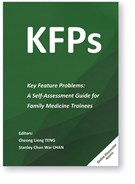Key feature problems: A self-assessment guide for family medicine trainees
Edited by Cheong Lieng Teng, Stanley Chun Wai Chan
Malaysia: Medical Education Publisher, 2017 ISBN: 978-967-14714-0-1
 The key feature problems (KFPs) component of The Royal Australian College of General Practitioners (RACGP) Fellowship examination is a source of great angst for many general practice registrars. I can personally relate to this through my experience as a candidate and, more recently, a medical educator. The KFP is a challenging assessment that measures knowledge and application in a highly contextualised environment. Exam technique is crucial, perhaps exacerbated by the relatively novel approach this assessment takes, which is often outside the candidate’s previous exam experience.
The key feature problems (KFPs) component of The Royal Australian College of General Practitioners (RACGP) Fellowship examination is a source of great angst for many general practice registrars. I can personally relate to this through my experience as a candidate and, more recently, a medical educator. The KFP is a challenging assessment that measures knowledge and application in a highly contextualised environment. Exam technique is crucial, perhaps exacerbated by the relatively novel approach this assessment takes, which is often outside the candidate’s previous exam experience.
Presently, there are few resources that provide an opportunity for registrars to practise answering questions in the style of the KFP exam. Pre-exam workshops are generally expensive and may be difficult for registrars to attend, particularly for those living in rural and remote areas. I was therefore very keen to see whether Key feature problems: A self-assessment guide for family medicine trainees was a reliable resource I could direct registrars to.
The nine contributors and reviewers are experienced family medicine practitioners and medical educators primarily based in Malaysia, where the KFP is also used for family medicine examinations. Four of them are joint fellows of the RACGP and examiners for the RACGP, and are therefore familiar with Australian requirements.
The book opens with a succinct but useful introduction, explaining what KFPs are and how to use the book. Four one-hour test papers, each containing seven KFP cases, follow. These are designed to be used as mini-practice exams, allowing opportunity for registrars to review their performance after each sitting, and refine their technique. The questions in the book provide an appropriate and helpful mix of clinical problems that registrars would be expected to manage, and test all five of the RACGP’s domains of general practice. The style of the questions is consistent with the actual RACGP KFP exam, requiring the registrar to apply their clinical knowledge and acumen.
The final section contains answers to the preceding questions. Each answer is accompanied by an explanation, highlighting the importance of providing very precise information, and is perhaps the most useful part of the book. Some cases or answers are specific to the Australian or Malaysian contexts (eg local laws); however, these questions could readily be adapted and remain useful nonetheless.
Registrars who purchase the book can join a Facebook discussion group organised by the editors, allowing them to discuss answers and seek further guidance. It is a closed group, and requires a written request to be mailed to the editors in Malaysia. This is a novel addition and one that some registrars might find helpful.
Overall, I believe this is a valuable resource for general practice registrars who are preparing to do the RACGP Fellowship exam, providing them an opportunity to practise KFP-style questions and improve their exam technique.
Sarah Mansfield MBBS (Hons), MSc, DCH, FRACGP, Medical Editor of Australian Family Physician